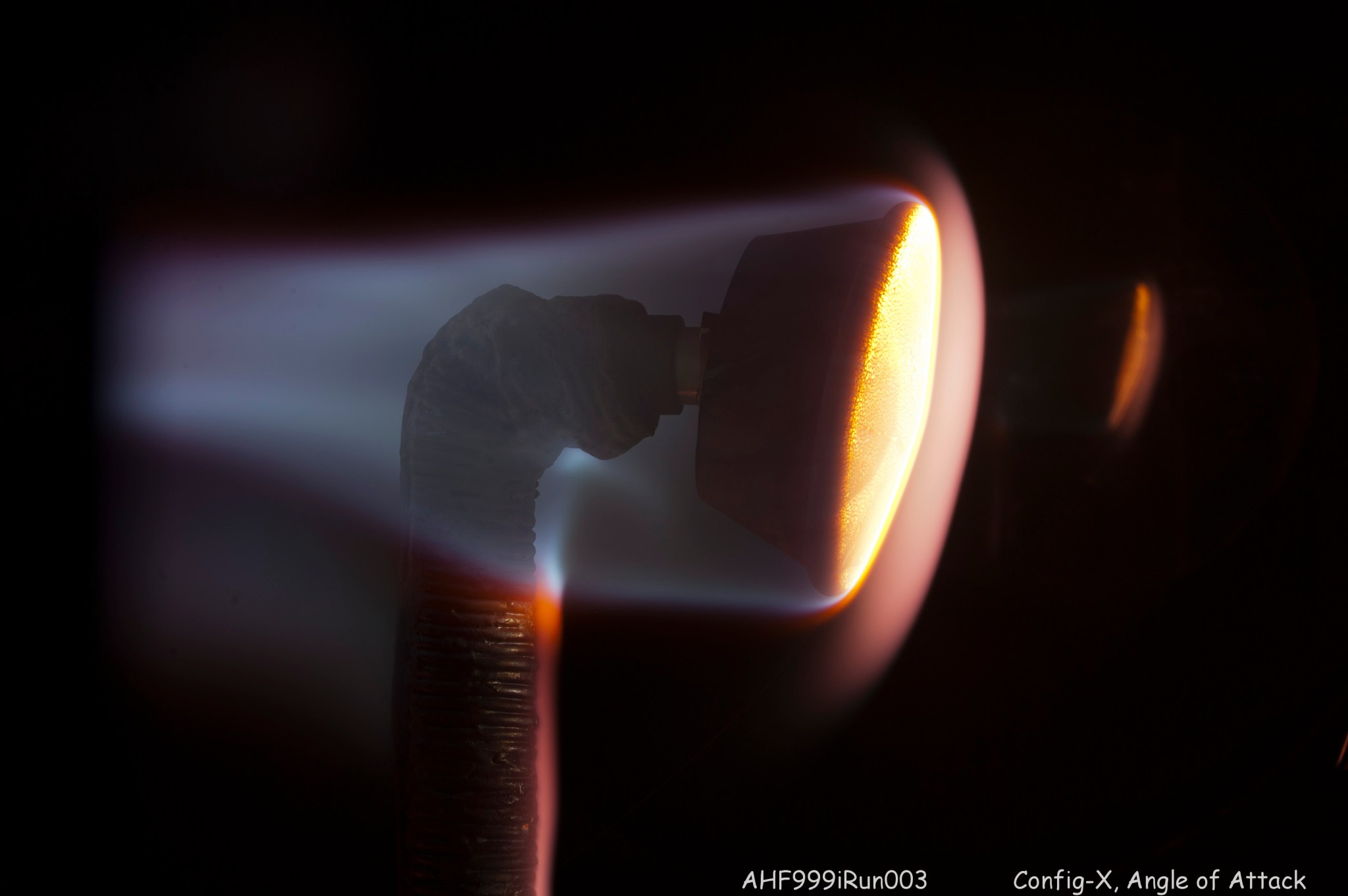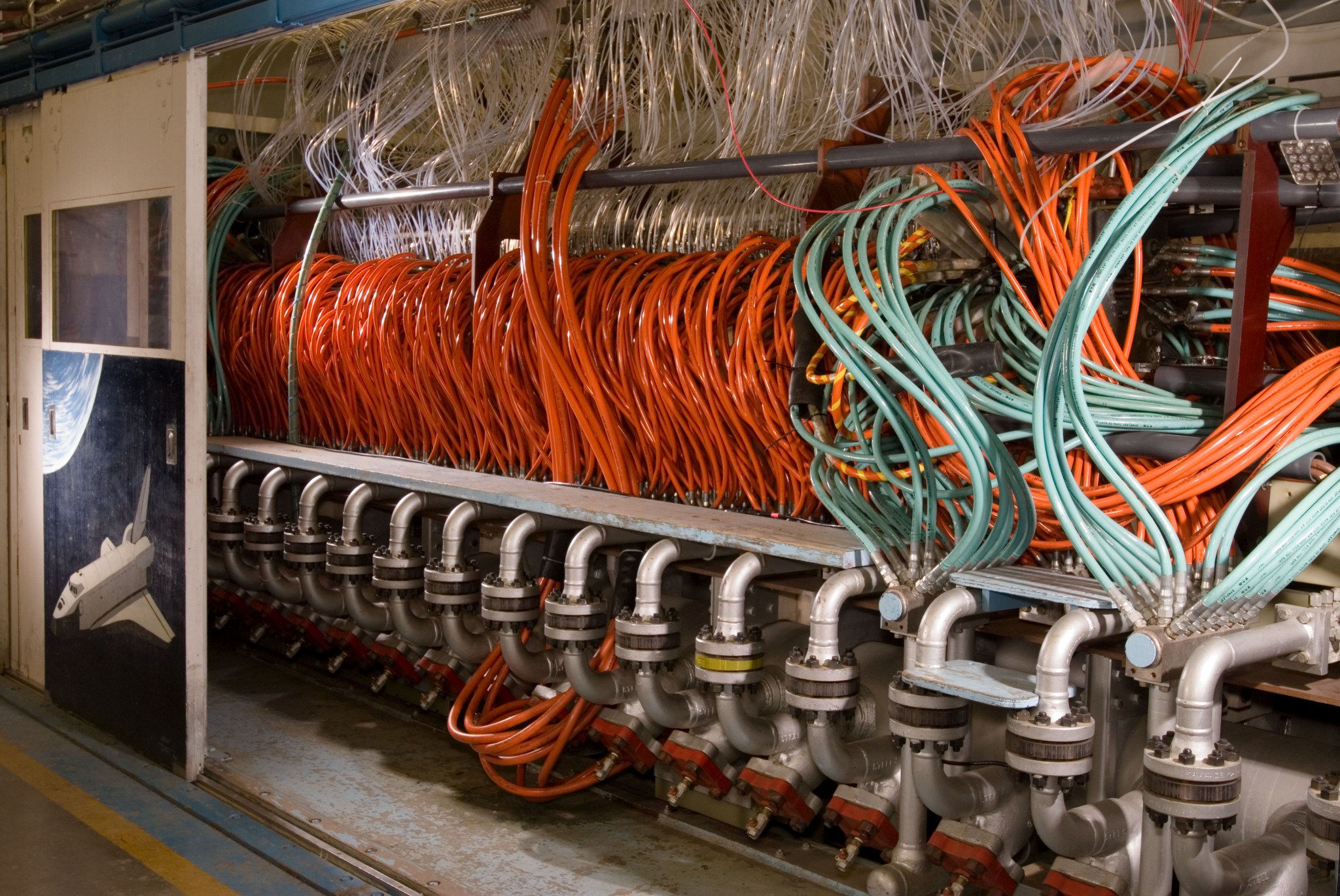NASA Ames Arc Jet Complex
Benefit
Innovative thermal protection materials and systems will be required to support NASA Exploration. Project missions, in particular crewed Moon or Mars return missions, will involve high velocity aerocapture or direct entry at Earth. These high stress missions will induce heating environments too severe for existing reusable Thermal Protection Systems (TPS). Qualifying a new TPS material for a crewed mission requires extensive testing to explore the limits of material performance, to validate reliability and repeatability of performance, to investigate the effects of material damage, and to develop a full database of material properties. Arc plasma facilities, operated by the Thermophysics Facilities Branch at NASA Ames, are critical to such a process, and to any other TPS developments required for Exploration missions, by providing the only ground-based simulation of flight entry conditions.
Moreover, Arc jet testing on fully instrumented samples, incorporating in-situ miniaturized heat flux, and temperature and recession sensors, can maximize test utility by enabling active test data (such as time-history of recession) and to aid in the development of an extensive database of in-depth thermal response and surface ablation.
Ames plans to develop its capabilities to continue to meet the needs of Human Exploration and Operations, Science, and Space Technology programs, through the continued update and improvements to the Arc Jet Complex.
The magnitude and capacity of these systems makes the Ames Arc Jet Complex unique in the world. The largest power supply can deliver 75 MW for a 30 minute duration or 150 MW for a 15 second duration. This power capacity, in combination with a high-volume 5-stage steam ejector vacuum-pumping system, enables facility operations to match high-altitude atmospheric flight conditions with samples of relatively large size.
The Thermophysics Facilities Branch operates four arc jet facilities within the Arc Jet Complex. The Interaction Heating Facility (IHF), with an available power of over 60-MW, is one of the highest-power arc jets available. It is a very flexible facility, capable of long run times of up to one hour, and able to test large samples in both a stagnation and flat plate configuration. The Panel Test Facility (PTF) uses a unique semielliptic nozzle for testing panel sections. Powered by a 20-MW arc heater, the PTF can perform tests on samples for up to 20 minutes. The Turbulent Flow Duct provides supersonic, turbulent high-temperature air flows over flat surfaces. The TFD is powered by a 20-MW Hüls arc heater and can test samples 203mm by 508mm in size. The Aerodynamic Heating Facility (AHF) has similar characteristics to the IHF arc heater, offering a wide range of operating conditions, samples sizes and extended test times. A cold-air-mixing plenum allows for simulations of ascent or high-speed flight conditions. Catalycity studies using air, simulated air, or nitrogen can be performed in this flexible rig. A 5-arm model support system allows the user to maximize testing efficiency. The AHF can be configured with either a Hüls or segmented arc heater (tungsten-button or multi-electrode), up to 20-MW.
Research Overview
The Ames Arc Jet Complex has seven available test bays. At the present time, four bays contain Arc Jet units of differing configurations, serviced by common facility support equipment. These are the Aerodynamic Heating Facility (AHF), the Turbulent Flow Duct (TFD), the Panel Test Facility (PTF and TPTF), and the Interaction Heating Facility (IHF). The support equipment includes two D.C. power supplies, a steam ejector-driven vacuum system, a water-cooling system, high-pressure gas systems, data acquisition system, and other auxiliary systems.
Background
The Ames Arc Jet Complex has a rich heritage of over 55 years in Thermal Protection System (TPS) development for every NASA Space Transportation and Planetary program including Apollo, Space Shuttle, Viking, Pioneer-Venus, Galileo, Mars Pathfinder, MER heatshield, Stardust, NASP, X-33, X-34, SHARP-B1 and B2, X-37 WLE TPS and most recently CEV/Orion heatshield development and Mars Science Laboratory TPS. Such a history has fostered the growth of extensive local expertise in the development and refinement of the arc jet facilities. The facilities of the Arc Jet Complex are used to simulate the aerothermodynamic heating that a spacecraft endures throughout hypersonic atmospheric entry, and to test candidate TPS materials and systems. The duration of such testing can range from a few seconds to more than an hour, and from one exposure to multiple exposures of the same sample.
An arc jet is a device in which gases are heated and expanded to very high temperatures and supersonic/hypersonic speeds by a continuous electrical arc between two sets of electrodes. The dissociated gases (typically air) pass through a nozzle aimed at a test sample in vacuum, and flow over it, producing a reasonable approximation of the surface temperature and pressure and the gas enthalpy found in a high velocity, hypersonic flow of the kind experienced by a vehicle on atmospheric entry. The Ames Arc Jets began in the 1950’s with the founding of a permanent facility in 1961. A breakthrough patented design in 1964 by Stein, Shepard and Watson of NASA Ames produced a high-enthalpy constricted-arc heater, which enabled TPS development for Mercury and Apollo missions.
The Ames Arc Jet Complex is key for customers involved in the three major areas of TPS development: selection, validation and qualification. The arc jet data are critical for validating TPS thermal models, heat shield designs and repairs, and ultimately for flight qualification.
The Arc Jets
Interaction Heating Facility (IHF) – The IHF is our most flexible test facility and is the largest in the Agency at 60-MW, large test section, and capable of test runs over one hour.
Aerodynamic Heating Facility (AHF) – Versatile facility, multi-insertion arms, multi-gas capability, Linde arc jet or segmented constricted arcs available.
Panel Test Facility (PTF & TPTF) – flat panel tests on 16 by 16 -inch samples from -5 to +8 degree angle of attack.
Turbulent Flow Duct (TFD or 2 x 9) – Fully turbulent flow at Mach 3+ internal channel for high shear heating.
POC
Ernest Fretter
Mail Stop 229-4
P.O. Box 1
Moffett Field, CA 94035-0001
Voice 650.604.6166
Fax 650.604.5422

























